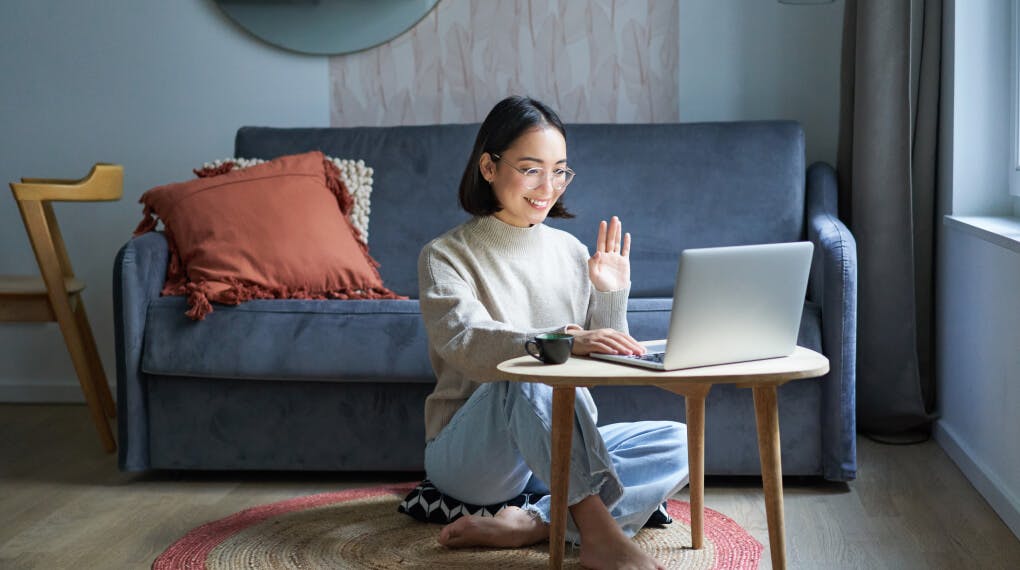Choosing the right working model is a critical decision that shapes your company culture, impacts collaboration, and directly affects your ability to attract and retain talent.
And, with work-life balance officially overtaking pay as the most important factor for employees for the first time in the 22-year history of the Randstad Work Monitor report, but many companies enforcing return-to-office mandates, flexible working models are more top of mind than ever.
Should you offer hybrid working? Fully remote positions? Or prioritise in-office collaboration?
There's no universal answer – but understanding what other European tech companies are doing can help you make an informed decision for your team.
In this guide, we'll break down the latest data on hybrid, remote, and in-office working models from Ravio's 2026 Compensation Trends Report, alongside practical advice on choosing the right approach for your company.
Hybrid vs remote vs in-office working: what's the difference?
Hybrid working means employees split their time between working remotely (usually from home) and working in the office. The specific split varies – some companies mandate certain office days, whilst others allow employees full flexibility to choose.
Remote working means employees work from a location outside the company's office. This can be either within the same country as the company's headquarters or internationally – some companies hire remote workers via an employer of record (EOR) like Deel or Remote to enable hiring across borders.
In-office working means employees work from the company's physical office location full-time.
Working models in 2025: The latest data shows that hybrid working is the most popular model by far
Hybrid working has firmly established itself as the dominant model across European tech.
Looking at Ravio's 2026 Compensation Trends report data:
- UK: 85% offer hybrid, 39% offer fully remote, 14% offer fully onsite
- Germany: 89% offer hybrid, 48% offer fully remote, 27% offer fully onsite
- Netherlands: 96% offer hybrid, 14% offer fully remote, 16% offer fully onsite
- France: 96% offer hybrid, 35% offer fully remote, 15% offer fully onsite
- Spain: 88% offer hybrid, 25% offer fully remote, 7% offer fully onsite
- Sweden: 75% offer hybrid, 49% offer fully remote, 19% offer fully onsite
Many companies offer different working models for different teams and roles, which explains why these figures total more than 100%.
The growth in hybrid working is particularly striking in the UK – from 77% of companies in 2022-3 to 85% today. This demonstrates that rather than rolling back flexible working arrangements, European tech companies are continuing to embrace them.
"After the cultural resets of 2022, most companies are now finding a middle ground between office mandates, employee autonomy, and performance expectations. It's no longer about choosing one over the others."

Founder of Darwin Total Rewards
How many days work from home do hybrid employees get?
Interestingly, Ravio’s data shows that, for many companies, "hybrid" has evolved to mean maximum flexibility rather than a prescribed split of office and home days.
In most markets, 5 days work from home per week is the most common policy for hybrid employees:
- Germany: 66% of companies allow employees to choose 5 days WFH
- Spain: 60% allow 5 days WFH
- UK: 55% allow 5 days WFH
- Sweden: 54% allow 5 days WFH
This suggests that "hybrid" increasingly means "work from wherever suits you best" rather than mandating specific office attendance.
However, France and the Netherlands take a different approach. In France, 55% of companies limit work from home to 2-3 days per week, whilst in the Netherlands it's 47%. This likely reflects different cultural attitudes toward workplace collaboration and management styles.
Is remote work going away in 2025?
Despite persistent headlines about return-to-office mandates, Ravio’s data shows that remote work is far from dead in European tech.
Between 39% and 49% of companies across European markets still offer fully remote positions, with Germany and Sweden leading at 48% and 49% respectively. Even in the Netherlands, which has the lowest adoption of fully remote working, 14% of companies still offer it.
This demonstrates that the broader tech ecosystem continues to embrace remote work as part of their talent strategy.
As Andrew Duncan from Atomico notes, founders considering predominantly in-office mandates are approaching it thoughtfully, recognising the trade-offs in talent acquisition that come with reducing flexibility.
"We are starting to see a trend of startup founders exploring predominantly in-office working again. The collaboration and efficiency gains of local, in-office teams are attractive. But they're being thoughtful about it, seeking advice on how much and which talent they'd sacrifice if they mandated 4 or 5 days in the office."

Talent Director at Atomico
Which working model is right for your company?
So how do you decide which approach works for your team?
Based on insights from Vaso Parisinou, Chief People Officer at Ravio (previously: Truelayer, Carwow, Deliveroo), here are four key considerations:

Tip 1: Learn the viewpoint of your founder(s) on working models and align the company’s culture with that
"Many start ups are founder-led, and that’s certainly been true of the start ups I’ve worked with over the years. Founder-led start ups are often more than just a company. They’re a manifestation of the vision and values of the founders – and that includes the type of working culture that they view as the best way to work.
Some founders have a deep conviction about the working model they envisage for their start up, whether it’s that remote-first is best or that there should be a minimum of three days in the office each week. Others founders want to be a servant leader, and instead prioritise what their wider team wants and needs.
As a People Leader you must understand and align with this.
When you start from this point of view of the company’s founding principles, it’s much easier to have conviction in the working model that you opt for, and to ensure that when hiring new team members you seek and find people whose beliefs and preferences in terms of ways of working are aligned to the company’s."
“Founders have the privilege of creating a culture they want to work within, and it’s vital for People Leaders to understand the viewpoint of their founder(s) and align with it when bringing a working model and culture to life.”

Chief People Officer at Ravio
Tip 2: Understand your employees’ preferences too – different working environments are right for different people
"Before Covid-19 there was huge resistance to working from home amongst leadership.
Then many companies had to swap to fully remote overnight with the lockdowns.
Now we’re seeing a correction, where companies are settling at two or three days in the office to get the best of both worlds – as we can see reflected in Ravio’s data in this article.
The option of remote working has undoubtedly been a positive, bringing new flexibility into working life and opening companies to new talent outside of their HQ location.
“I love that I don’t have to feel anxious or guilty about asking my manager if I can work from home one day to get my boiler sorted anymore. If I’ve slept badly one night and need an extra hour of sleep, I can choose to skip the commute that day, no questions asked. The flexibility that hybrid and remote working options have brought is what I personally value in my working life.”

Chief People Officer at Ravio
At the same time, remote working is also a privilege. Not everyone has a lovely, calm office space to use at home and the ability to accept increased home energy bills. At its worst, home working was even found to lead to an increase in domestic abuse during the Covid-19 lockdowns.
Plus, time working together in the office as a team has huge positives in terms of community building and collaborative working.
“I do feel we miss out on an important life experience through 100% remote work. Working together as a team, in-person, brings with it a sense of community and belonging. Plus, there are those all important conversations and connections across functions and seniority levels that com organically when working in close proximity and are super important for our careers – sitting next to people, having tea breaks with them, and so on.”

Chief People Officer at Ravio
As HR and People Leaders we have to be hyper aware of both sides of the coin – different things suit different employees.
That means asking and listening to the needs and wants of employees alongside those of the founders. And it means avoiding making any drastic changes to an established working model, that could lead to great team members deciding to move on.
For instance, at Ravio we’ve seen those community-building and collaboration benefits from in-office working, and I heard from several team members that they were keen to have more time together in the office.
But, at the same time, we know that some team members see our flexibility on remote working as a major benefit – so we didn’t want to go too far on in-office time.
As a result, last year we increased from one mandatory in-office day per week to two for our hybrid employees (we have some fully remote employees working outside of our HQ location of London too). Nothing drastic enough to rock the boat, but enough to make sure we adjust our approach towards what’s working best for us as a company and a team."
Tip 3: Be prepared to put in the work to make your chosen working model work
"Making mandatory in-office days successful requires work and central organisation.
From documenting (and enforcing!) policies on which days of the week are office days to ensuring enough desks and meeting spaces to accommodate everyone and much more.
The same is true of remote-first workplaces too – things like implementing internal comms systems and processes, and planning global onsites to ensure remote workers get time together too are really important to make a remote culture work.
As a company you need to be intentional about putting things like this in place to make sure your chosen working model actually works for your team.
And since most start ups won’t have a dedicated office manager early on, much of this work will fall to the HR and People team!
“No one wants to head into the office for a working day, only to find they’re the only one there. Equally, if 50 people are in the office and everyone’s sat with headphones on in virtual meetings, that’s a nightmare too!”

Chief People Officer at Ravio
If you’re building a remote culture, I’d recommend reading the article ‘Quick and Dirty Remote 101’ by Jessica Zwaan for some stellar advice on making remote, cross-border working work."
Tip 4: Accept that you may need to flex towards remote working to close new hires
"As we saw at the start of this article, job candidates are still making flexible work and remote options a priority (remember those findings of the EY 2023 employee survey that 50% of employees are only willing to go to the office once a week, and a third would prefer a fully remote job).
With remote jobs so popular, even if you have a preference for a company culture where employees work in the office at least some of the time, you may well need to compromise on that when competing for talent.
In tech, for instance, the talent market for software engineering roles is renowned for being hyper-competitive, and it’s very common for software engineers to only consider fully remote jobs today.
If you have a job position which needs to be filled, and mandatory office working days are the one thing holding you back, you’re going to need to be ok with compromising on that as a tactical hiring decision to attract talent – and you need to be sure that your founder(s) and leadership team understand and are ok with that too."
“Say you have a critical Site Reliability Engineer role you’ve been trying to fill for a while. You’ve interviewed 500 people and finally have a great candidate that wants the job. But, they’re asking for the role to be fully remote instead of two mandatory office days. Are you really going to say no and interview another 500 candidates for the role? Of course not! That would be a ridiculous hiring funnel, we’d simply have to give them the flexibility.”

Chief People Officer at Ravio
FAQs
What is a hybrid working model?
A hybrid working model combines remote work with in-office time, ensuring collaborative time as a team, whilst giving employees the flexibility to work from home.
But "hybrid" doesn't mean the same thing everywhere. Some companies mandate specific office days each week, whilst others offer complete flexibility.
What is an example of a hybrid working model?
A common hybrid working model is having two mandatory office days per week (such as Tuesday and Wednesday), with employees able to work from home or choose to work in the office for the remaining three days. However, many companies now offer maximum flexibility within their hybrid model, allowing employees to choose up to 5 days working from home per week.
What are the benefits of a hybrid working model?
The benefits of hybrid working models include:
- Collaboration and connection: Unlike fully remote models, hybrid working maintains opportunities for in-person collaboration. Teams can schedule office days around key meetings, workshops, or social events, building the relationships and spontaneous conversations that drive innovation and career development.
- Flexibility and work-life balance: Hybrid models give employees greater control over when they commute and when they’re able to work from home. This means they can manage personal commitments more easily, avoid rushed morning commutes on days when they need extra rest, and create working environments that suit their individual needs.
- Attracting and retaining talent: With flexibility now a top priority for employees, hybrid models help companies remain competitive in the talent market without sacrificing the benefits of in-person working entirely.
What is the difference between hybrid and remote working?
Hybrid working means employees split their time between working remotely and working in the office, with varying levels of flexibility depending on company policy. Remote working means employees work entirely from outside the office, either within the same country or internationally, with no regular office attendance expected.





